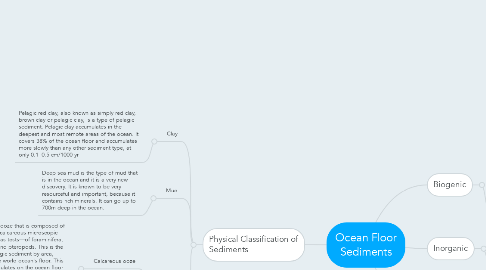
1. Physical Classification of Sediments
1.1. Clay
1.1.1. Pelagic red clay, also known as simply red clay, brown clay or pelagic clay, is a type of pelagic sediment. Pelagic clay accumulates in the deepest and most remote areas of the ocean. It covers 38% of the ocean floor and accumulates more slowly than any other sediment type, at only 0.1–0.5 cm/1000 yr
1.2. Mud
1.2.1. Deep sea mud is the type of mud that is in the ocean and it is a very new discovery. It is known to be very resourceful and important, because it contains rich minerals. It can go up to 700m deep in the ocean.
1.3. Ooze
1.3.1. Calcareous ooze
1.3.1.1. Calcareous ooze is ooze that is composed of at least 30% of the calcareous microscopic shells—also known as tests—of foraminifera, coccolithophores, and pteropods. This is the most common pelagic sediment by area, covering 48% of the world ocean's floor. This type of ooze accumulates on the ocean floor at depths above the carbonate compensation depth. It accumulates more rapidly than any other pelagic sediment type, with a rate that varies from 0.3–5 cm/1000 yr.
1.3.2. Siliceous ooze
1.3.2.1. is ooze that is composed of at least 30% of the siliceous microscopic "shells" of plankton, such as diatoms and radiolaria. Siliceous oozes often contain lesser proportions of either sponge spicules, silicoflagellates or both. This type of ooze accumulates on the ocean floor at depths below the carbonate compensation depth. Its distribution is also limited to areas with high biological productivity
